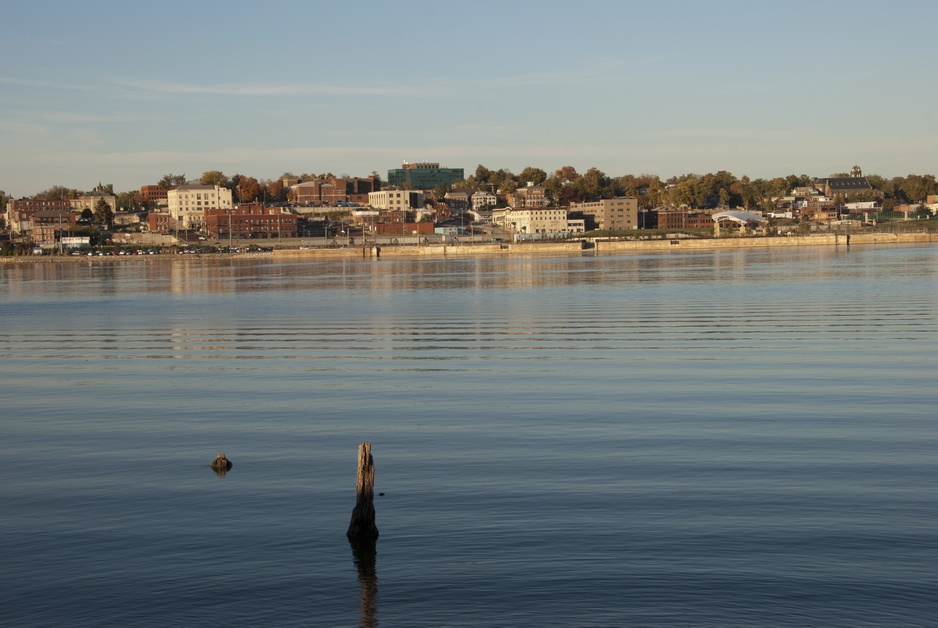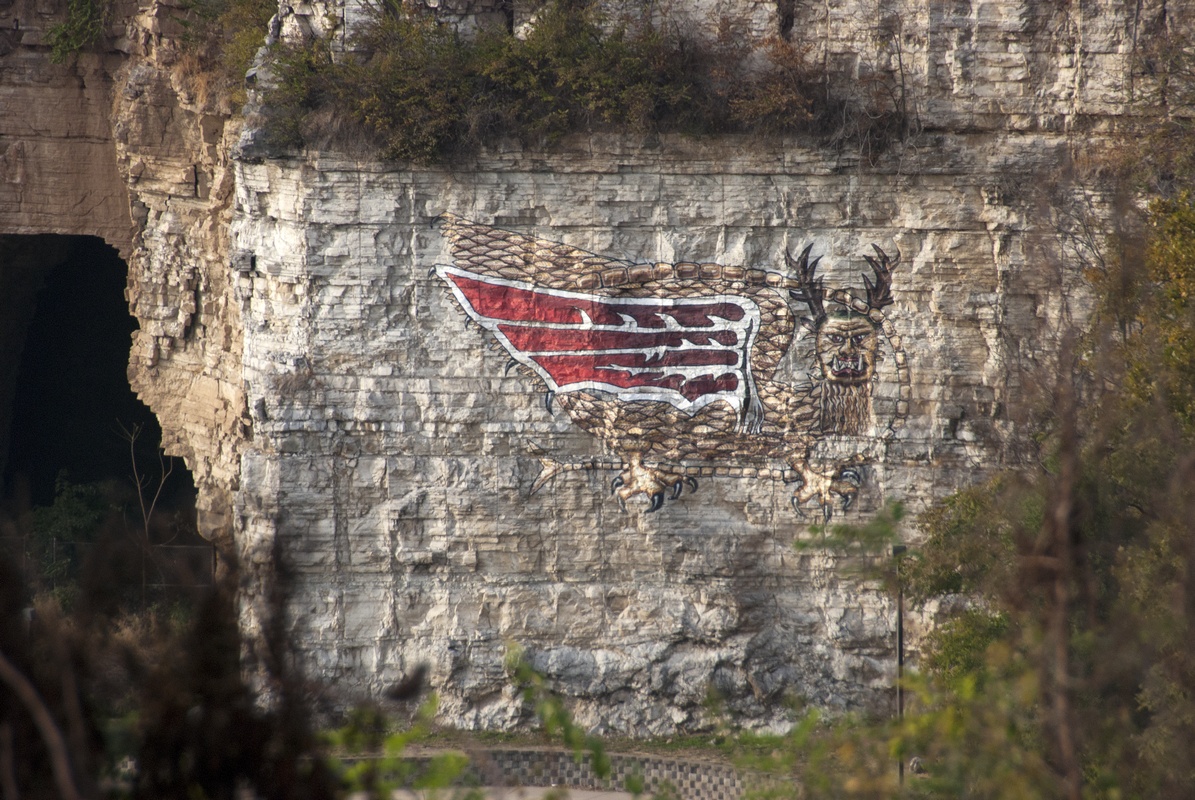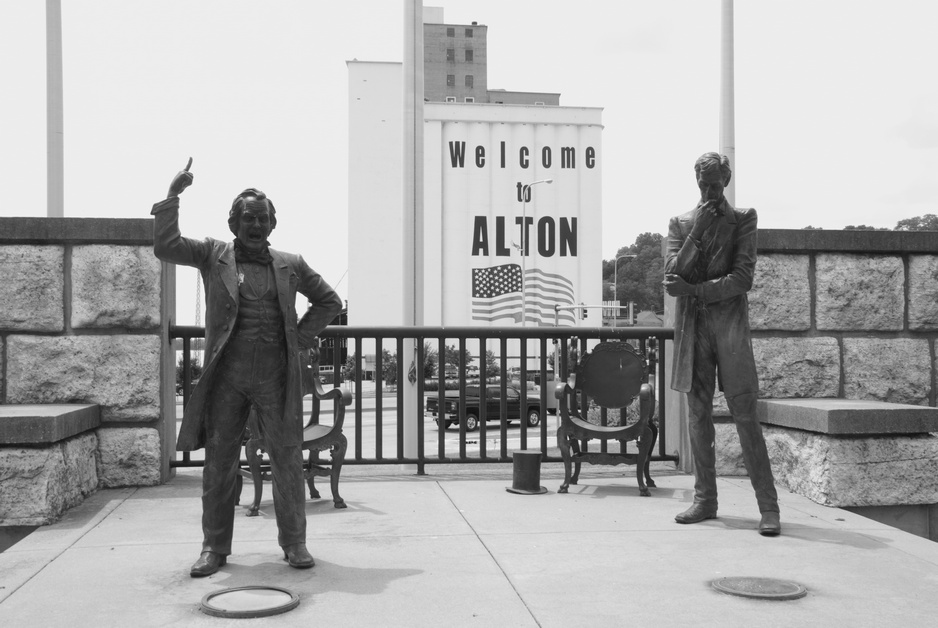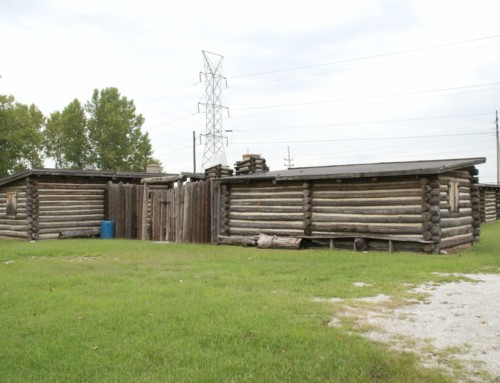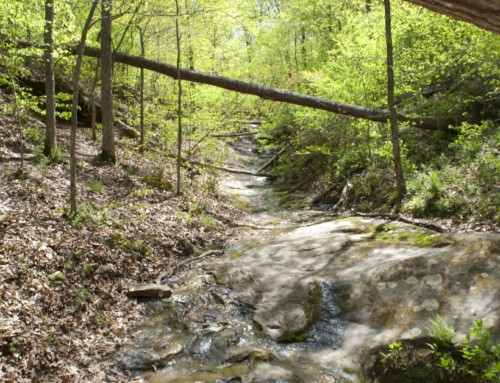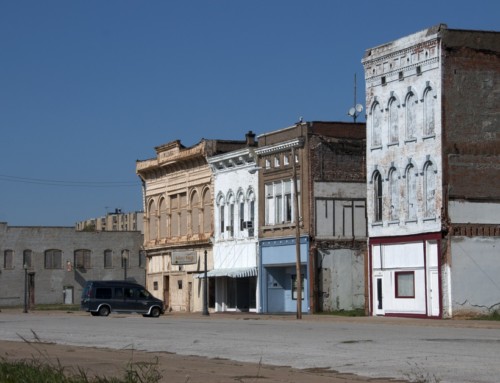Introduction
Alton is a city with a layered history that is worth the time to explore. When you’re done, take a drive along the Mississippi River up to Grafton, which is one of the most scenic stretches of the Great River Road; it can be very busy on weekends with cars, motorcycles, and bicycles.
Visitor Information
Direct your questions to the folks at Great Rivers & Routes (200 Piasa St.; 618.465.6676).
History
Alton sits at the upriver end of a wide floodplain known as the American Bottom. It has long been an attractive place to live for its fertile soil and easy access to rivers, which is part of the reason that the largest pre-Colombian civilization in North America (what we now call Cahokia Mounds) flourished here.
Today’s Alton was once six separate communities: Alton, Upper Alton, North Alton, Hunterstown, Salu, and Milton Heights. The community known as Alton was laid out by Colonel Rufus Easton in 1817 and named for his oldest son; he named a few streets after his other children. The original Alton is now the downtown area; it eventually absorbed two other towns and incorporated in 1837.
Early Alton had a mix of residents from around the US, including many from the South. When Elijah Lovejoy moved from St. Louis to Alton in 1835 to continue printing his abolitionist newspaper, The Observer, some folks weren’t too happy. A mob stormed his office before he could get the first issue printed and threw the printing press into the Mississippi River. That was his second press; a mob in St. Louis had destroyed his first press. Lovejoy bought another press and published for about a year until that one was also destroyed. Not easily deterred, he bought his fourth press and stored it in a warehouse near the river. When news leaked about the new printing press, a mob assembled and went to the warehouse to confront Lovejoy. They attacked the warehouse in the middle of the night and this time they didn’t just go after the machine, they also went after Lovejoy, killing him. In spite of the number of witnesses, no one was successfully prosecuted for the murder.
The issue of slavery didn’t go away with Lovejoy’s murder. When Abraham Lincoln and Stephen Douglas met for their seventh and final debate in a US Senate contest, slavery was still the central issue. Both men arrived in Alton at dawn on October 15, 1858, on the steamer City of Louisiana. Later that day, thousands of people turned out to hear the two men’s views. Douglas later won the Senate seat, while Lincoln had to settle for the US Presidency two years later.
Abe Lincoln had one other connection to Alton, one he rarely talked about. In 1842, he publicly chided James Shields, then the Illinois State Auditor, about Shields’ role in a plan to close the failing Illinois State Bank. Lincoln wrote a letter to the editor of the Sangamo Journal under the pen name Rebecca, in which he assumed the persona of a distressed farmer to attack Shields’ politics and his character. Lincoln showed the letter to Mary Todd, with whom he had recently reconciled, and a couple of days later she wrote an anonymous letter of her own, apparently without Abe’s knowledge.
Shields was not amused. He found out who was behind the letters and demanded that Lincoln write a retraction. When Lincoln refused, Shields challenged him to a duel, naturally. As the one who was challenged, Lincoln got to choose the weapons; he chose broadswords. Lincoln was six feet, four inches tall, a full seven inches taller than Shields and with a much wider wingspan. He hoped that choosing swords would encourage Shields to change his mind. It didn’t.
On September 22, the two met in Alton, then traveled downriver to Bloody Island at St. Louis to swing their swords at each other. (Dueling was illegal in Illinois but not Missouri.) Standing face-to-face with a plank marking the line between them, Lincoln swung his sword above Shields’ head, slicing off a tree branch. That demonstration apparently sobered Shields, who, with the encouragement of friends, agreed to a truce. Shields accepted a muted apology from Lincoln, and the two men put the swords down and went their separate ways.
They would meet again, though. During the Civil War, Shields was a Brigadier General in the Army of the Potomac. After Shields’ forces defeated Stonewall Jackson at the Battle of Kernstown, Lincoln promoted Shields to Major General, so two men had apparently moved past their previous differences.
Alton had the distinction of being the site of the first state prison in Illinois. Opened in 1833, the prison was a regular target of criticism from reform advocates like Dorothea Dix, in part because the site was a notorious vector for spreading deadly diseases. The prison closed in 1860 as the new Joliet prison opened, but about two years later it saw new life during the Civil War as a detention center for captured Confederate soldiers. During the war, nearly 12,000 Confederate prisoners spent some time at the prison, alongside a few civilians—men and women—arrested for treason or for committing acts of terrorism.
The Alton prison was deadlier than the average Union prison, mostly because diseases like dysentery and pneumonia were common. When a small pox epidemic erupted in the winter of 1862, three hundred prisoners were moved to an island across the river for quarantine where most of them died and were buried. At least 1,500 Confederate soldiers died in the prison; most were buried in North Alton. The prison closed again on July 7, 1865, and was torn down gradually; most of the stones were re-used in construction of buildings around town.
Alton’s early fortunes were closely tied to the Mississippi River. In 1841 alone, Alton counted 1,100 steamboat landings. River traffic was so central to the city’s life that some homes and businesses were built with special platforms at the top, from which folks could watch for approaching steamboats.
By 1850, Alton had grown to over 3,500 residents, about 5% of whom were free blacks. The first African Methodist Episcopal Church was established in 1839 in Lower Alton to serve the growing community.
Factories grew as steamboating declined; the city’s first grain mill opened in 1831; the city still has an active grain processing facility. One of the largest employers was the Illinois Glass Company. It grew from a modest operation with 74 employees in 1873 to a local giant with 3,200 people working there thirty years later. The company employed nearly half of the city’s workforce at that time and was once one of the largest manufacturers of glass bottles in the world. In 1929, the company merged with the Owens Bottle Company of Toledo, creating Owens-Illinois Glass Company; the factory closed in 1984.
Apart from the glass company, Alton once had factories that produced lead, steel, chemicals, and box-board. In addition, the quality of the local clay supported several potteries for a while.
Altonians have survived and rebuilt after many floods. One of the worst was in 1844, before the city had a large population. Steamboats floated across flooded fields far away from where the main channel would normally have been. In modern times, the flood of 1993 was the most damaging, but the Mississippi River has stretched into town since then, most recently in 2016 and 2017.
One of the city’s best known and beloved residents was Robert Wadlow. After an unassuming birth on February 22, 1918, Wadlow began to grow at an unusually fast rate. When he started kindergarten, he was already 5’ 6” tall, and by ten years of age he had surpassed six feet in height. An exceptionally active pituitary gland was responsible. His size made life a challenge at times. He had to custom order his clothes and had to climb stairs sideways because his feet were so big (size 37 AA).
Still he never complained about anything, living his life with grace. He traveled with his father for a while, which gave him a lot of opportunities to see the country. While visiting Manistee, Michigan, with his father, he developed a blister on his foot that became infected. Doctors couldn’t get it under control. On July 15, 1940, he died; he was just 22 years old. At the time of his death, he was 8’ 11” tall and weighed 490 pounds, the tallest man who ever lived. Five thousand people turned out at his funeral to say goodbye.
Exploring the Area
Downtown Alton is easy to explore on foot. Alton was one of the sites for the famous Lincoln-Douglas debates; check out their statues in Lincoln Douglas Square (100 Market St.). Jazz legend Miles Davis lived a chunk of his life in Alton, which is why the city placed a statue of him on 3rd Street downtown in Miles Davis Memorial Plaza.
The unique collection at The Soul Asylum (301 E. Broadway; 618.468.1051) mixes stories and artifacts about Alton history with replicas of ancient torture devices and local hauntings. Not a combination one sees everyday but fitting for a museum in the ill-fated Mineral Springs Hotel.
A tall column in Alton City Cemetery (5th St. at Monument St.) honors the memory of slain abolitionist Elijah Lovejoy, whose printing presses were repeatedly destroyed before he was murdered by a pro-slavery mob in 1837. Alton National Cemetery (600 Pearl St.; 314.845.8320) is located in the northeast corner of the same cemetery; it is the final resting place for about 500 veterans who served in conflicts from the Civil War to Vietnam.
You can see a piece of a Lovejoy press in the lobby of the Hayner Public Library’s Genealogy and Local History Library (401 State St.). It was salvaged from the Mississippi River in 1915.
Think you’re tall? Stand next to the life size statue of Robert Wadlow (2810 College Ave.), the world’s tallest man, and find out.
The Alton Museum of History and Art (2809 College Ave.; 618.462.2763) has several displays on the city’s history, with exhibits on Wadlow, steamboats, the Piasa legend, and more.
For a good overlook of the Mississippi River, head up to Riverview Park (450 Belleview St.; 618.463.3580).
Another tall monument honors the Confederate soldiers who died in Alton while imprisoned during the Civil War (635 Rozier).
Heading north on the Great River Road, you’ll notice a bird-like image painted on the side of a bluff. In 1673, Father Jacques Marquette and Louis Joliet passed a similar cliff painting near present-day Alton. Marquette described it:
While Skirting some rocks, which by Their height and length inspired awe, We saw upon one of them two painted monsters which at first made Us afraid, and upon Which the boldest savages dare not Long rest their eyes. They are as large As a calf; they have Horns on their heads Like those of a deer, a horrible look, red eyes, a beard Like a tiger’s, a face somewhat like a man’s, a body Covered with scales, and so Long A tail that it winds all around the Body, passing above the head and going back between the legs, ending in a Fish’s tail. Green, red, and black are the three Colors composing the Picture. Moreover, these 2 monsters are so well painted that we cannot believe that any savage is their author; for good painters in France would find it difficult to reach that place Conveniently to paint them.
Marquette and Joliet were the only Europeans to see the painting and write down a description of it. A modern interpretation of the Piasa Bird image is now painted on a bluff just north of Alton along Highway 100.
Culture & Arts
The Jacoby Arts Center (627 E. Broadway; 618.462.5222) hosts rotating exhibits that feature the work of local and regional artists, plus they occasionally host concerts.
Check the calendar at Alton Little Theater (2450 N. Henry St.; 618.462.3205) for an evening of live theater.
Sports & Recreation
There are miles and miles of dedicated bike paths in this area:
- the 20-mile Sam Vadalabene Trail runs from Alton to Pere Marquette State Park.
- the 21-mile Confluence Bike Trail runs from Alton to Hartford.
Tours
Alton has a reputation for being home to more tortured spirits than your average place. If you want to get in touch with the haunted souls, several tours can help you reach them.
The McPike Mansion (2018 Alby St.; 618.830.2179), built in 1869, has been existing in purgatory since it was last occupied in the 1950s; many local tours take guests here to show off its haunted nature. The mansion itself offers one or two tours a month during the summer, then every weekend in October. Tours are currently limited to the cellar, until the rest of the house is restored.
You can also take a haunted tour with one of these companies:
- Alton Hauntings (217.791.7859) leads a walking tour around downtown
- Mineral Springs Haunted Tour (866.465.3205) also leads walking tours around downtown, as well as through the old four-story hotel
- Alton Haunted Odyssey (618.462.3861) takes guests to haunted sites around town in a presumably non-haunted trolley in October and November
For non-ghost-themed tours, J.E. Robinson Underground Railroad Tours (618.462.5590) highlights Altonians’ history of helping enslaved people escape to freedom. Once a month (in season), the Great Rivers and Routes Tourism Bureau offers Underground Railroad tours via a shuttle around town (800.258.6645).
Bluff City Tours offers a range of options, including tours that feature Alton history (618.466.8693).
Entertainment and Events
The Argosy Casino (1 Piasa St.; 800.711.4263), one of the first on the river when it opened in 1991, is also one of the last Mississippi River casinos that still floats, although the casino no longer takes excursions
Farmers Market
Warmer weather brings fresh produce. In Alton, you’ll find the farmers market on Saturday mornings and Wednesday evenings in the parking lot at the corner of Landmarks Boulevard and Henry Street.
Festivals
The Alton Memorial Day Parade is the oldest such parade in the US; Alton had its first parade in 1868 when the holiday was called Decoration Day. The route begins at Alton Middle School and follows College Avenue to Washington, then loops around the square and back to Washington before ending at Upper Alton Cemetery.
In September, downtown streets are closed for a river-themed celebration called the Mississippi Earthtones Festival. The event features art and craft vendors, organizations that offer nature-based activities, and live music.
Alton stages a popular Halloween parade, a tradition that dates back to 1916.
**Alton is covered in Road Tripping Along the Great River Road, Vol. 1. Click the link above for more. Disclosure: This website may be compensated for linking to other sites or for sales of products we link to.
Where to Eat and Drink
AUTHOR’S PICK: Housed in an old commercial building on the riverfront, the Old Bakery Beer Company (400 Landmarks Blvd.; 618.463.1470) brews some fine beer, and they put as much effort into the food, too. The sandwiches are delicious and the sides inventive. They also host live music on some nights.
Pick up a fresh baked good or something sweet at LuciAnna’s Pastries (607 E. Broadway St.; 618.433.9395) or stick around for a tasty lunch, such as a savory quiche.
Duke Bakery (819 Henry St.; 618.462.2922) has been pleasing palates since 1951. They have a nice selection of fruit tarts, in addition to donuts, cannoli, and cream horns.
Get a cup of coffee at Maeva’s Coffee (1320 Milton Rd.; 618.581.7510), in a converted turn-of-the-century schoolhouse.
Germania Brew Haus (617 E. Broadway St.; 314.667.4751) is another good option for coffee, in a building that once housed a bank. They also have a self-service beer tap and occasionally host live music.
Fast Eddie’s Bon Air (1530 E. 4th St.; 618.462.5532) is the sprawling complex famous for cheap food, good drinks, and live music. They can get very busy on weekends.
My Just Desserts (31 E. Broadway St.; 618.462.5881), housed in a 19th-century storefront downtown, offers healthy choices for lunch, as well as delicious, sweet treats to balance out that healthy food you just ate.
The Brown Bag Bistro (318 E. Broadway; 618.433.9933) is another fine choice for a tasty lunch that you can enjoy on the patio or take with you. They offer a good range of salads, hearty sandwiches, and soups. They can be very busy at times.
Johnson’s Corner (2000 State St.; 618.465.5640) is a good choice for pizza or a big pork tenderloin.
Gentelin’s on Broadway (122 E. Broadway; 618.465.6080) has been pleasing Altonians with fine dining for a decade. Enjoy peppered ribeye or wild mushroom ravioli with a glass of wine and a good view of the river.
Where to Sleep
Bed and Breakfasts
A stay in one of the rooms at the 10,000-square-foot Beall Mansion (407 E. 12th St.; 618.474.9100) is a step back in time where you get to take modern luxuries with you, plus you can pretty much eat all the chocolate you can handle.
Three art-inspired rooms are the theme at Tiffany Inn (410 E. Broadway St.; 618.462.4145), a bed-and-breakfast in downtown Alton above a stained-glass studio.
Moderate and Up
Lodging at the Alton Cracker Factory (205 E. Broadway St.; 618.917.4466) comes with great views and beautiful, contemporary rooms.
Resources
- Hayner Public Library: 326 Belle St. (Downtown branch); 618.462.0677 .
- Post Office: 2350 Homer Adams Pkwy.
- Newspaper: Alton Telegraph
Where to Go Next
Heading upriver? Check out Godfrey.
Heading downriver? Check out East Alton.
Community-supported writing
If you like the content at the Mississippi Valley Traveler, please consider showing your support by making a one-time contribution or by subscribing through Patreon. Book sales don’t fully cover my costs, and I don’t have deep corporate pockets bankrolling my work. I’m a freelance writer bringing you stories about life along the Mississippi River. I need your help to keep this going. Every dollar you contribute makes it possible for me to continue sharing stories about America’s Greatest River!
©Dean Klinkenberg, 2018,2020

